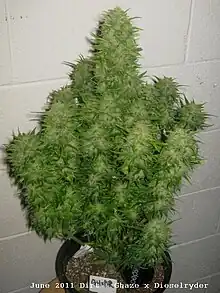| Part of a series on |
| Cannabis |
|---|
 |

Autoflowering cannabis or day neutral cannabis varieties automatically switch from vegetative growth to the flowering stage based on age, as opposed to the ratio of light to dark hours required with photoperiod dependent/short-day strains. Many autoflowering varieties are ready to harvest in less than 10 weeks from seed.[1][2] Dwarf varieties can have short stature[3] while still giving decent harvests.
Origins
The origins of autoflowering cannabis are still debatable. The strain Lowryder by breeder The Joint Doctor was the original large scale marketed autoflower.[4][5] Lowryder contains genetics from a Mexican strain that was referred to as Mexican Rudy and is believed to be created from a cross between a Mexican sativa and a Russian Cannabis ruderalis. Another theory is that the early genetics came from the first oilseed hemp variety called Finola, which was developed from Russian stock in Finland during 1995.[6] These early hybrids with large amounts of C. ruderalis genes[7] were lacking some of the finer qualities of high grade cannabis strains available.
The ruderalis subspecies of cannabis is highly resilient. Native to the harsh climates of Russia, central Europe, and central Asia, ruderalis was officially identified in the wild regions of South Siberia by Janischewski, a Russian botanist, back in 1924.
Further hybrids from these ruderalis dominant strains were created using some of the more popular and standard photo-period sensitive strains. Since the first mass market autoflower, Lowryder, many improvements have been made by breeders.[8] Because the effect was weak when consuming it due to its low THC levels, autoflowers weren't popular among recreational users.
A couple of years after its characteristics became known, autoflowering strains[9] became of high interest to cannabis breeders.[10] Breeders started developing ruderalis hybrids that had high THC or CBD levels and only needed around 9 weeks to completely mature. These hybrids became known as autoflowering cannabis, for its ability to flower automatically without depending on darkness, like normal photoperiodic strains.
Characteristics
Cannabis ruderalis has naturally low concentrations of THC. With hybrid breeding, autoflowering plants can contain levels of THC similar to the strain they're bred with.[11][2]
Breeders have reported THC content around 25% in some newer varieties while many varieties also have high CBD content.[12]
Some advantages of autoflower plants include:
- Short time to harvest, usually going from seed to harvest in under 13 weeks (some as short as seven weeks)[2]
- Can be kept short in stature for "stealth" growing
- The Cannabis ruderalis heritage causes flowering after 2–3 weeks from germination
- No need for a separate vegetative and flowering environment (unlike with photoperiod dependent/ short-day strains)
- Due to short life span can be grown in cold climates where summers are short and cold[13]
- Can produce multiple harvests outdoors in one season[14]
- Can be grown in areas of high light pollution without preventing flowering or causing hermaphroditism
Most autoflowering seeds available in the market are feminised. Only a few brands offer regular autoflowering seeds.
Breeding
Creating true autoflowering seed from two quality, true breeding autoflowering parent plants is easy for most.[15] Breeding new autoflowering strains becomes more difficult when attempting to make a hybrid with a non-autoflowering strain. Some photoperiod/short-day cannabis strains are heterogeneous - containing the recessive day-neutral or autoflowering genetics along with the dominant short-day genetics. However a proper list of such strains is not yet available so most breeders treat all short-day plants as homozygous dominant.
A true autoflower is homozygous recessive[16] for the day neutral genetics. Therefore, most crosses between classical photoperiod/short-day strains and autoflowers produce few or no autoflower progeny in the F1 generation. Regardless of whether the F1 generation produces autoflowering plants, the higher performing and similar plants need to be recrossed. This F2 generation will contain approximately 25% of homozygous recessive plants which are autoflowering. Still the few autoflowers produced are not always stable and may require further stabilization. Further complexities with stabilizing autoflowers has previously led to non-autoflowering and low quality strains making it into the market.
See also
Notes
- Cannabis, Sir Ross (2015). Cannabis Botany and Marijuana Horticulture Naturally Medicinal. Maison Hydroponique Publishing. ISBN 978-1548501594. Archived from the original on 2017-08-07. Retrieved 2017-08-07.
References
- ↑ Downs, David (15 April 2014). "How To Grow Organic Pot". East Bay Express.
- 1 2 3 Vassilevska-Ivanova, R. (2019). "Biology and ecology of genus Cannabis: genetic origin and biodiversity. In vitro production of cannabinoids" (PDF). Genetics and Plant Physiology. Institute of Plant Physiology and Genetics – Bulgarian Academy of Sciences. 9 (1–2): 75–98.
- ↑ David, Steve (2 November 2011). "Hydroponics Autoflowering Marijuana: Seed to Harvest in 70 Days or Less!". Big Buds. Archived from the original on 2014-04-26.
- ↑ "The history of autoflowering cannabis seeds". Canabbis.Info. 7 December 2017.
- ↑ Handbook of cannabis. R. G. Pertwee (First ed.). Oxford. 2014. ISBN 978-0-19-163969-2. OCLC 891957662.
{{cite book}}: CS1 maint: location missing publisher (link) CS1 maint: others (link) - ↑ "Guide To Auto Industrial Hemp Farming for CBD".
- ↑ van Bakel, Harm; Jake M Stout; Atina G Cote; Carling M Tallon; Andrew G Sharpe; Timothy R Hughes; Jonathan E Page (24 October 2011). "The draft genome and transcriptome of Cannabis sativa" (PDF). Genome Biology. 12 (10): R102. doi:10.1186/gb-2011-12-10-r102. PMC 3359589. PMID 22014239. S2CID 10674584. Archived from the original (PDF) on 2015-02-16. Retrieved 2014-04-25.
- ↑ "Best Auto Flowering Cannabis Seeds".
- ↑ "Autoflowering Seeds". Blimburn Seeds. 12 March 2018.
- ↑ "10 Fast-Growing Autoflower Strains for Impatient Cannabis Growers". International Highlife. 14 April 2020.
- ↑ "Should Beginners Start With Autoflowering Cannabis Strains?". www.zamnesia.com. Retrieved 2021-04-14.
- ↑ Larry, Gabriel. "Beyond THC". Metro Times.
- ↑ Midowo. "What are autoflowering cannabis seeds". www.autoflowering-cannabis.com. Archived from the original on 2013-10-02.
- ↑ Elliot. "How And When To Harvest Cannabis Plants". unitedcannabisseeds.com. Archived from the original on 2021-07-10.
- ↑ Geber, Monica A. (1999). Gender and sexual dimorphism in flowering plants : with 29 tables. Berlin [u.a.]: Springer. ISBN 978-3540645979.
- ↑ Said, Nuff. "Cannabis Seeds and Basic Breeding". ISmoke Magazine. Retrieved 25 April 2014.